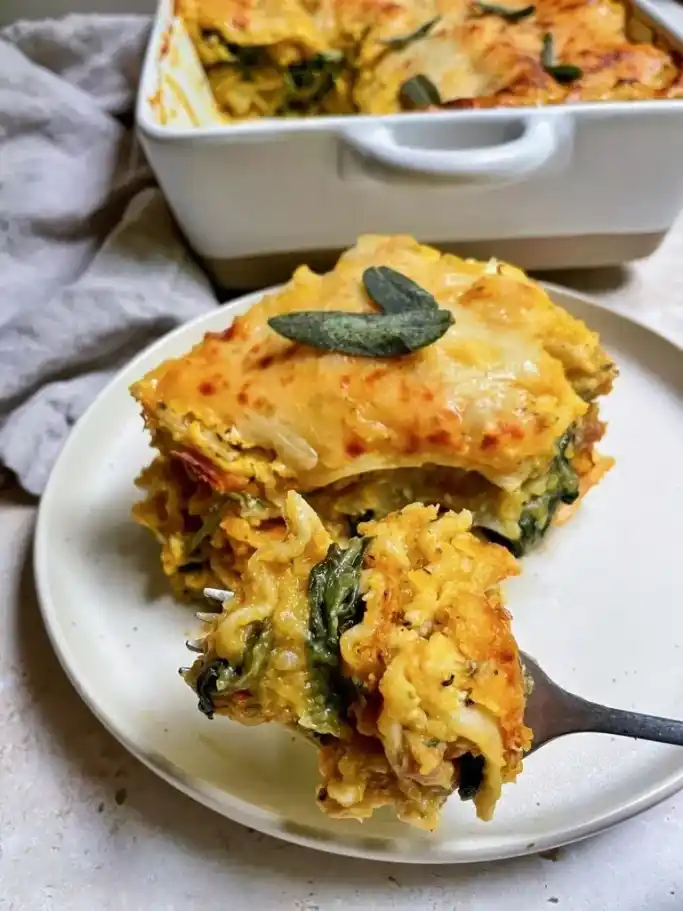Butternut squash lasagna is the kind of dish that wraps you in warmth and flavor, making it perfect for any occasion.
This recipe combines the natural sweetness of butternut squash with creamy layers and savory spices, creating a comforting meal that everyone will love.
As you prepare this dish, the sweet aroma of roasted squash and fresh herbs fills your kitchen, inviting everyone to gather around the table.
Each layer of noodles, rich sauce, and tender vegetables brings a delightful taste and texture that’s both satisfying and nourishing.
Whether you’re cooking for family, friends, or simply treating yourself, butternut squash lasagna is a heartwarming choice that turns any meal into a celebration.
It’s easy to make and full of flavor, proving that cooking can be both simple and rewarding.
Get ready to create a memorable dish that will leave everyone asking for seconds!
Table of Contents
ToggleButternut Squash Lasagna
Ingredients
For The Butternut Squash Puree
- 6 cups butternut squash, peeled, seeded, and cubed
- 7 cloves of garlic, smashed
- 1 ½ cups yellow onion, roughly chopped
- 7-8 sprigs of thyme
- 10 fresh sage leaves
- 3 tablespoons olive oil
- 1 cup vegetable broth
For The Bechamel Sauce
- 4 tablespoons all-purpose flour
- 3 tablespoons ghee or olive oil (choose ghee for a richer flavor)
- ¼ of a yellow onion, unchopped
- 3 cups milk (use any dairy or non-dairy milk you prefer)
- ½ teaspoon salt
- ½ teaspoon black pepper
- ¼ teaspoon nutmeg (optional)
For Assembly
- 1 package of lasagna noodles
- 1 package of fresh spinach
- 14 ounces of chicken sausage
Instructions
- Preheat your oven to 400°F (200°C). Line a large baking sheet with parchment paper.
- Spread the cubed butternut squash, smashed garlic, chopped onion, thyme, and sage on the baking sheet. Drizzle with olive oil and season generously with salt and pepper.
- Roast for 30-35 minutes until the squash is very tender. Let it cool for about 10 minutes. Then, combine it in a food processor with vegetable broth and blend until smooth. Taste and adjust the seasoning if needed.
- In a large sauté pan over medium heat, add the chicken sausage. Use a wooden spoon to crumble it as it cooks until browned. If there’s excess fat, drain it on a paper towel and then transfer to a bowl.
- In the same pan, add the fresh spinach and cook until it wilts but remains bright green. Add it to the bowl with the sausage.
- In a medium saucepan over medium-low heat, melt the ghee (or olive oil). Whisk in the flour and cook for about 2 minutes, stirring constantly.
- Gradually pour in the milk while whisking vigorously to prevent lumps. Add the unchopped onion for flavor. Season with salt, pepper, and nutmeg. Bring the sauce to a gentle boil, then reduce the heat and simmer for another 2-3 minutes.
- Cook the lasagna noodles according to the package instructions, unless you are using oven-ready noodles.
- Spray the bottom and sides of a 9×13 inch baking dish with cooking spray.
- Start with a layer of butternut squash puree, then a layer of noodles. Spread 1/3 of the bechamel sauce over the noodles.
- Add half of the cooked sausage and spinach mixture, then another 1/3 of the butternut squash puree.
- Repeat this layering process: noodles, bechamel, remaining sausage and spinach, and more squash puree.
- Finish with a final layer of noodles topped with the remaining bechamel sauce and butternut squash puree.
- Cover the lasagna with aluminum foil and bake in the oven at 375°F (190°C) for 40 minutes.
- Remove the foil, add cheese if desired, and broil for 5 minutes or until the cheese is melted and golden brown. Keep a close eye to prevent burning!

Expert Tips For Perfect Butternut Squash Lasagna
To ensure your butternut squash lasagna turns out delicious every time, consider these expert tips:
- Choose the Right Squash: Look for firm, heavy butternut squashes with a smooth, beige skin. Avoid any with soft spots or blemishes.
- Prep Ahead: Roasting the squash in advance not only enhances its flavor but also saves time when you’re ready to assemble the lasagna.
- Layering Technique: Alternate layers of squash puree, béchamel sauce, and noodles. This helps with even cooking and flavor distribution. Start and end with a layer of sauce to keep the noodles moist.
- Season Generously: Don’t be afraid to season each layer—squash, béchamel, and vegetables benefit from a little salt and pepper to bring out their natural flavors.
- Cheese Choices: Experiment with different cheeses like ricotta, mozzarella, or Parmesan. Mixing them can create a more complex flavor profile.
Ideal Side Dishes To Serve With Butternut Squash Lasagna
Pairing your butternut squash lasagna with the right side dishes can elevate your meal. Here are some wonderful options:
- Simple Green Salad: A light salad with mixed greens, cherry tomatoes, and a lemon vinaigrette complements the richness of the lasagna.
- Garlic Bread: Crispy, buttery garlic bread is a favorite choice. You can even sprinkle some parsley on top for added flavor.
- Roasted Seasonal Vegetables: Roasted carrots, zucchini, or bell peppers can add color and nutrients, balancing the meal nicely.
- Steamed Asparagus or Broccoli: These veggies provide a fresh crunch and a bright color, enhancing your plate’s appeal.
- Fruit Salad: A refreshing fruit salad can be a sweet counterpoint to the savory lasagna, perfect for cleansing the palate.
How To Store Leftover Butternut Squash Lasagna?
To keep your leftover lasagna fresh and tasty, follow these storage tips:
- Cooling Down: Allow the lasagna to cool for about 30 minutes at room temperature. This prevents condensation in your storage container.
- Airtight Containers: Use airtight containers to store leftovers. If you’re using a baking dish, cover it tightly with plastic wrap or foil to minimize exposure to air.
- Labeling: If you’re storing multiple meals, label your containers with the date so you can keep track of freshness.
Can Butternut Squash Lasagna Be Frozen?
Freezing is a great option if you want to enjoy your butternut squash lasagna later. Here’s how to do it effectively:
- Before Baking: Assemble the lasagna but do not bake it. Wrap it tightly in plastic wrap and then aluminum foil to prevent freezer burn. Label with the date and use within 3 months for best quality.
- After Baking: If you have leftovers, let the lasagna cool completely, then cut it into portions. Wrap each piece in plastic wrap and place them in a freezer bag or airtight container.
How To Reheat Butternut Squash Lasagna?
Reheating your lasagna properly can make it taste just as good as when it was freshly made. Here are the best methods:
- Oven Method: Preheat your oven to 350°F (175°C). Place the lasagna in an oven-safe dish, cover with foil to keep it from drying out, and bake for 25-30 minutes, or until heated through. You can remove the foil for the last 5-10 minutes to allow the top to crisp up.
- Microwave Method: For a quick option, place a slice of lasagna on a microwave-safe plate. Cover with a damp paper towel and heat on medium power for about 2-4 minutes, checking every minute until hot.
- Stovetop Method: If you want to avoid using the oven or microwave, you can reheat a slice on the stovetop. Place it in a skillet over low heat, cover it with a lid, and heat for about 5-10 minutes, adding a splash of water to create steam if needed.

Can I Use Frozen Butternut Squash?
Yes, you can use frozen butternut squash in lasagna, and it’s a convenient choice if fresh squash isn’t available. Here’s how to make it work:
- Thaw First: Let the frozen squash thaw fully in the fridge, or use the defrost setting on your microwave.
- Drain Excess Water: Frozen squash can become watery, so pat it dry with paper towels after thawing to avoid excess moisture in your lasagna.
- Roast for Extra Flavor: Spread the thawed squash on a baking sheet and roast it for about 10 minutes at 400°F (200°C) to bring out a deeper, caramelized flavor.
How Do I Know When The Lasagna Is Done?
It can be hard to tell when lasagna is ready, but there are a few signs to watch for to make sure it’s perfectly cooked:
- Bubbly Edges: The edges should be bubbling, indicating that the sauce is hot and the layers are cooking through.
- Golden Top: The top layer should be golden brown, especially if cheese is added. If it’s still pale, give it a few more minutes.
- Noodle Texture: Insert a fork into the center. The noodles should be tender and easy to cut through. If they’re still firm, bake for a bit longer.
For extra accuracy, you can also insert a thermometer into the center, which should read about 160°F (70°C). This temperature means the lasagna is hot enough all the way through.










